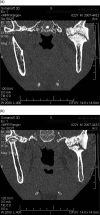Osteoma of temporomandibular joint: a rarity
- PMID: 24014334
- PMCID: PMC3794170
- DOI: 10.1136/bcr-2013-200268
Osteoma of temporomandibular joint: a rarity
Abstract
Osteoma is a benign tumour consisting of mature bone tissue. It is an uncommon lesion that occurs in the bones of the craniofacial complex. Only a few cases involving the temporomandibular joint have been reported. An osteoma of the left temporomandibular joint causing limited mouth opening in a 22-year-old man with CT findings revealing the unusual possibility in differential diagnosis of trismus.
Figures







Similar articles
-
Osteoma of the condyle as the cause of limited-mouth opening: a case report.J Oral Sci. 2004 Mar;46(1):51-3. doi: 10.2334/josnusd.46.51. J Oral Sci. 2004. PMID: 15141724
-
[Tumors in the region of the temporomandibular joint].Beitr Orthop Traumatol. 1970 Jan;17(1):23-4. Beitr Orthop Traumatol. 1970. PMID: 5511193 German. No abstract available.
-
Chronic temporomandibular joint pain: two cases of osteoid osteoma and a review of the literature.Int J Oral Maxillofac Surg. 2017 Sep;46(9):1130-1137. doi: 10.1016/j.ijom.2017.03.036. Epub 2017 May 8. Int J Oral Maxillofac Surg. 2017. PMID: 28495394 Review.
-
[Tumors affecting the temporomandibular joint - a literature review].Bull Cancer. 2020 Nov;107(11):1186-1198. doi: 10.1016/j.bulcan.2020.05.015. Epub 2020 Oct 12. Bull Cancer. 2020. PMID: 33059872 Review. French.
-
Prosthodontic and surgical management of a patient with an osteoma of the temporomandibular joint.Compend Contin Educ Dent. 1998 Mar;19(3):258, 260, 262 passim. Compend Contin Educ Dent. 1998. PMID: 9590949
Cited by
-
Peripheral Osteoma of the Mandibular Condyle-Case Series.Dent J (Basel). 2022 Sep 29;10(10):182. doi: 10.3390/dj10100182. Dent J (Basel). 2022. PMID: 36285992 Free PMC article.
-
Central compact osteoma of mandibular condyle.BMJ Case Rep. 2020 Feb 10;13(2):e233082. doi: 10.1136/bcr-2019-233082. BMJ Case Rep. 2020. PMID: 32047087 Free PMC article.
-
Mandibular Condyle Osteoma.Ann Maxillofac Surg. 2019 Jul-Dec;9(2):434-438. doi: 10.4103/ams.ams_174_19. Ann Maxillofac Surg. 2019. PMID: 31909031 Free PMC article.
References
-
- Park W, Nam W, Park H, et al. Intraosseous lesion in mandibular condyle mimicking temporomandibular disorders: report of 3 cases. J Orofac Pain 2008;2013:65–70 - PubMed
-
- Siar CH, Jalil AA, Ram S, et al. Osteoma of the condyle as the cause of limited mouth opening: a case report. J Oral Sci 2004;2013:51–3 - PubMed
-
- Yonezu H, Wakoh M, Otonari T, et al. Osteoma of mandibular condyle as cause of acute pain & limited mouth opening: case report. Bull Tokyo Dent Coll 2007;2013:193–7 - PubMed
-
- Yang C, Qiu WL. Osteoid osteoma of the eminence of temporomandibular joint. Br J Oral Maxillofac Surg 2001;2013:404–6 - PubMed
-
- Kademani D, Bevin C. A mass in the temporomandibular joint. J Am Dent Assoc 2008;2013:301–3 - PubMed
Publication types
MeSH terms
LinkOut - more resources
Full Text Sources
Other Literature Sources
Medical
